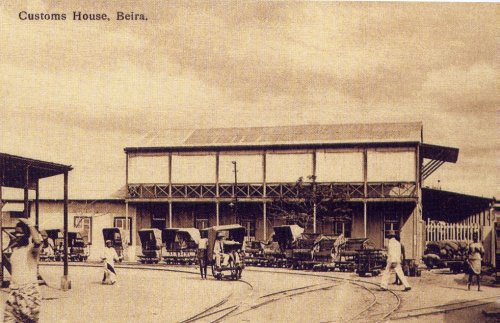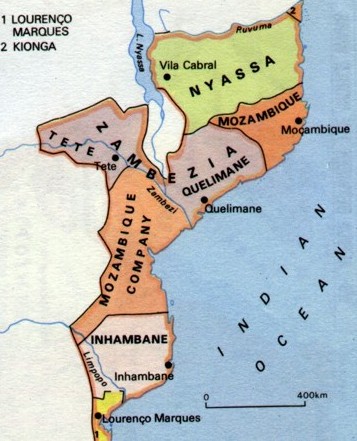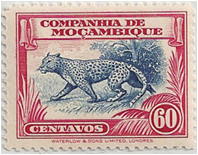ALBUM – View my Mozambique Company album
TRANSITION CHART – Mozambique Area
Fast Facts
Region: Southern Africa
Group: Mozambique Area
Classification: Colony, Portuguese
Prior Regime: Mozambique Colony
Key Dates:
1498, Mar 1 – Vasco da Gama lands on Mozambique Island and “claims” the region of Portugal
1752 – Colony of Moçambique, Zambesi and Sofala separated from Portuguese India in Goa
1891, Feb 11 – Mozambique officially chartered
1902 & 1917 – Local rebellions arose requiring military intervention from Portugal
1942, Jul 18 – Mozambique Company returns territory to Portuguese Colonial Authorities
Following Regime: Mozambique Colony
Scott Catalogue: (Mozambique Company) 1-207, B1-B7, C1-C15, J1-J40, P1, RA1-RA4
Pick Catalogue: (Mozambique) R1-R33
Currency: 1000 reis = 1 milreis, beginning 1912 100 centavos = 1 escudo
History

Although Portugal had laid claim to much of middle Africa between Mozambique and Angola, it was forced to cede much of the territory during the “Scramble for Africa” in the 1880s to larger British interests. Portugal did however retain its “rights” over Mozambique as confirmed at the Berlin Conference of 1885. Mozambique’s infrastructure was developed with assistance from the British, as both British Central Africa/Nyassaland and Northern Rhodesia both depended on railroads and roads connecting to ports in Beira and Mozambique.
In 1891 the Portuguese shifted its approach to development of colonial areas to large privately held companies which were granted control over much of the resources, taxation, and infrastructure (including postal services) of the territory granted to them. These chartered companies were given exemption from taxes for 25 years in exchange for 10% ownership and 7.5% of the profits. The largest charters were given in 1891 to the Mozambique Company for 50 years to administer the territories of Manica and Sofala, and to the British owned Nyassa Company for 35 years to control the territory in the north. In 1892, the Zambezia Company was also established to administer the area around the Zambezi River, although it was never officially chartered.
 The Mozambique Company (Companhia de Moçambiqe), established its capital in Beira, and was primarily funded by large private British investments. The company was considered by the Portuguese government to be ineffective, as they didn’t meet many of its obligations to develop the territory. Instead, most of its income was derived from heavy taxation of the locals, and relying on large amounts of forced labor for work on its plantations. This practice resulted in at least two major rebellions in which Portugal had to militarily intervene at great expense.
The Mozambique Company (Companhia de Moçambiqe), established its capital in Beira, and was primarily funded by large private British investments. The company was considered by the Portuguese government to be ineffective, as they didn’t meet many of its obligations to develop the territory. Instead, most of its income was derived from heavy taxation of the locals, and relying on large amounts of forced labor for work on its plantations. This practice resulted in at least two major rebellions in which Portugal had to militarily intervene at great expense.
When the charter expired in 1942, Portugal did not renew the agreement, and the territory was returned to the colonial authority of Mozambique.
Stamps
 ALBUM
ALBUM
As postal authority was granted to the chartered companies, Mozambique Company is known to have issued some of the most attractive stamps of the classical era which were very popular among collectors.
The first postage stamps issued 1892 were stamps of Mozambique Colony, featuring an embossed cameo of King Carlos, overprinted ” COMP.A DE MOÇAMBIQUE” in red or black. Most of these initial issues were reprinted in 1905 for collectors. Reprints are usually paler in color, have a white gum and a clean cut perforation of 13-1/2.
In 1895, the first Mozambique Company stamps were issued featuring the Coat of Arms of the Company, which is a shield with a crown on top, flanked by two upright elephants. This stamp design was used until 1918, although with various overprints and surcharges were applied.
On 5 Oct, 1910, a coup d’état was overthrew the constitutional monarchy in Portugal, and established a republican regime. Reflecting this change, all stamps beginning in 1911, were diagonally overprinted the word “REPUBLICA”. Additionally, a new currency was introduced in Portugal on 22 May 1911 (centavos replacing reals), but for some reason stamps in Mozambique Company did not reflect this change until 1916, when stamps were surcharged. It may be possible with all of the turmoil in Lisbon; it took a while to have stamps issued in such a remote province.
Beginning in 1918, Mozambique Company began issuing a beautiful set of engraved stamps featuring various scenes of the life and the crops of Mozambique. This was followed up with additional sets including designs featuring wildlife, scenery, history and the native population. Mozambique Company continued to design and issue attractive and colorful stamps until the end of its charter in 1942. These stamps were very popular among collectors, and the company made quite a handsome income by selling Canceled to Order (CTO) stamps to dealers.
Banknotes
Mozambique Company issued its own banknotes beginning in 1919 through the Bank of Beira. Beginning in 1930, banknotes began to be issued directly under the Companhia de Moçambique.
Two different currencies were issued: The Portuguese currency where 100 Centavos = 1 Escudo, and a second currency, the Libra which was equal to 1 British Pound. The Libra was issued in Mozambique from 1914 – 1938.
Links
History of Mozambique – Hubert de Vries heraldry
The British Ultimatium of 1890
Photos from Mozambique Company
COMPANHIA DE MOÇAMBIQUE from filatelia





“Confused? 😉 Take a look at the Mozambique Area Transition Chart at the Dead Countries Stamps website. Thanks Michael!”
Michael-
I linked your wonderful Mozambique Area Transition Chart in the Lourenco Marques post just published at bigblue1840-1940.blogspot.com
Thanks a lot!
Jim J